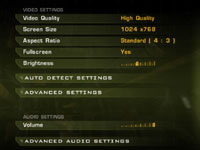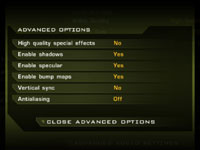Quake 4
Publisher: ActivisionWe used the full retail version of Quake 4 patched to version 1.3.0. It's the fourth game in the Quake series, based on the technically sound Doom 3 engine. However, unlike Doom 3, we found that the game benefits from at least 2x anti-aliasing, and the experience with anti-aliasing at a slightly lower resolution was better than increasing the resolution with no AA applied.
Both anti-aliasing and anisotropic filtering were controlled from inside the game. When you select "High Quality" mode, 4xAF is automatically enabled, and when the "Ultra Quality" mode is enabled, 8xAF is automatically applied to the scene.
We used a custom-recorded demo from a section that represents fairly typical performance throughout the rest of the game. We set the in-game details to high quality and left Vsync disabled. Both anti-aliasing and anisotropic filtering were controlled inside the game using console commands. Anti-aliasing was adjusted using the "r_multisamples" cvar, while anisotropic filtering values were set using "image_anisotropy".
Quake 4 is an interesting title in many ways, but it’s not because the EVGA e-GeForce 8800 Ultra performs particularly badly, it’s because the Radeon HD 2900 XT performs so well. Despite EVGA’s supercharged 8800 Ultra costing almost double the price of the Radeon HD 2900 XT, it only delivers 15 percent more performance at 2560x1600 4xAA 8xAF with high quality in-game details.
We’re sure that this gap will probably increase if you forced “ultra quality” textures, but let’s be honest, there’s not much of a visible image quality benefit with that setting enabled. With both cards running above 60fps, it’s questionable whether you’re going to notice much difference in the game, especially considering there is a 60fps cap in Quake 4.
Comparing EVGA’s e-GeForce 8800 Ultra Superclocked to other single card solutions, there’s no question that it’s is the fastest card we’ve tested. At best, it’s around six percent faster than the reference GeForce 8800 Ultra and just over ten percent faster than EVGA’s previous flagship graphics card.
When you bring similarly priced multi-GPU configurations into the fray, things change a little though. Both the Radeon HD 2900 XT CrossFire and GeForce 8800 GTS 640MB SLI configurations are faster, but the performance picture is dominated by ATI’s new card when it comes to bang for buck.

MSI MPG Velox 100R Chassis Review
October 14 2021 | 15:04











Want to comment? Please log in.